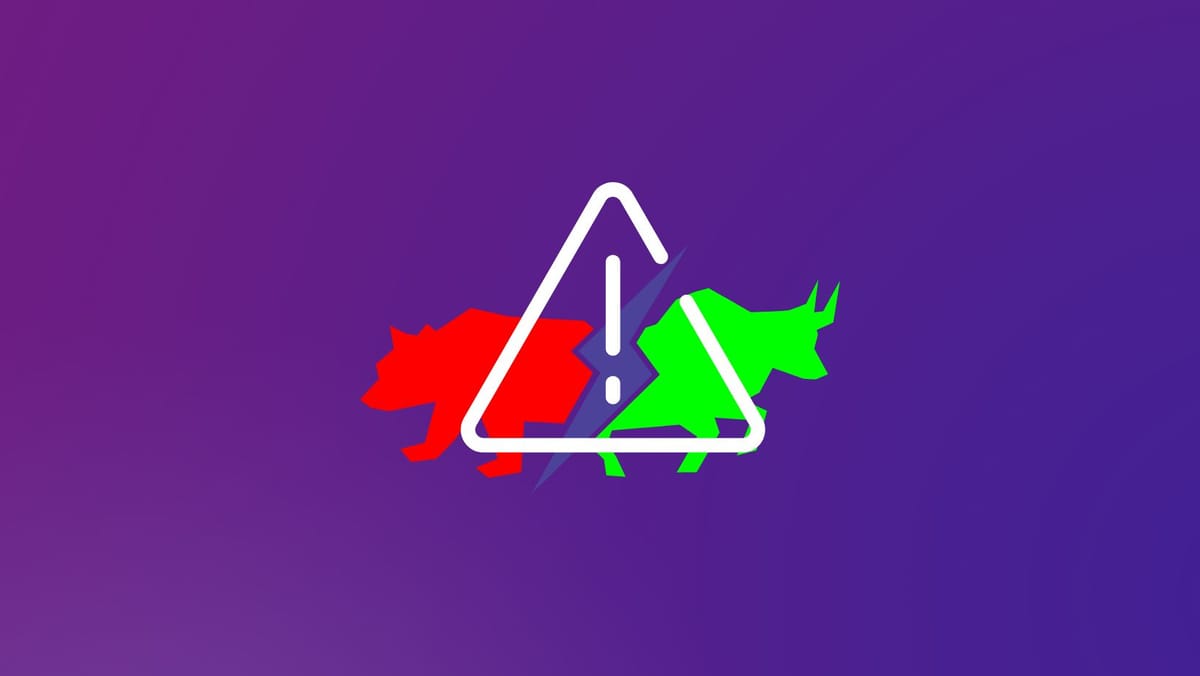8 Common Crypto Trading Mistakes And How To Avoid Them

Crypto trading offers both excitement and financial rewards. However, as with any business, it also comes with its fair share of risks. Even experienced traders can fall prey to mistakes, leading to hefty losses. To help you avoid such pitfalls, we've compiled a list of eight common crypto trading mistakes and how to avoid them.
No Trading Strategy
Trading crypto without strategy is playing with fire. You get burnt, eventually.
One of the most common crypto trading mistakes beginner traders may encounter is the lack of a trading strategy. This mistake is often rooted in the sense of urgency and impatience that drives traders to seek immediate results without adequate consideration of the risks and challenges of the market.
Windfall profits are possibly in sight. But this initial success is a trap, our portfolios are about to go up in smoke.
A well-defined trading strategy provides traders with the flexibility and awareness needed to navigate market movements. Such a strategy should be based on a clear understanding of both short-term and long-term goals and should incorporate key elements such as target gains, acceptable loss levels (i.e., stop loss), and time commitments.
By starting with clear and realistic targets and developing a solid plan, traders can minimize the chance of regret and maximize their potential for long-term success.
Lack Of Knowledge
Trading is a series of constant tests, and we're supposed to be learning.
The pursuit of learning, diligent research, and astute analysis is of the utmost importance. However, traders are easily tempted to hastily enter the lucrative world of trading without first dedicating ample time to knowledge enrichment.
Gaining entry into the crypto market may be relatively simple, but mastering it is an entirely different matter. Broadening your knowledge and skillset is never an unwise investment of time. Indeed, the depth of your knowledge is a critical determinant of success or failure in the trading arena.
Fundamental analysis gives you the idea of a project with strong growth potential based on influential factors, while technical analysis helps forecast future movements of the price. These typical types of analysis are clear evidence of how knowledge strengthens your trading positions.
Through the acquisition of knowledge, traders can effectively determine the current market trend, be it an uptrend or downtrend, and make informed decisions about whether to buy or sell assets.
Insufficient knowledge can prove dangerous, particularly in instances where incorrect decisions are made. Without the necessary knowledge, the underlying reasons for incorrect decisions may remain unknown, leaving traders vulnerable to repeating the same mistakes in future similar situations.
Failing to learn is learning to fail. To thrive in the volatile crypto market, it is imperative to refine your expertise consistently, keep a close eye on price fluctuations and charts, and make decisions based on logical analysis of the market.
Choose The Wrong Platform
Choosing the wrong platform sounds uncommon. But many of us have been there, and it's perfectly understandable.
How things could go wrong when choosing a good platform to trade crypto?
Navigating the rapidly evolving landscape of trading platforms can be overwhelming, and it is not uncommon for traders to be tempted by flashy marketing, misleading statements, or seemingly low fees.
Many new traders jump into this step without doing research. The rush, unfortunately, shows no mercy on their trading success and potential profits. It is crucial to take the time to research and evaluate different platforms thoroughly.
Here are some essential criteria to consider when choosing the right exchange to trade cryptocurrency:
- Security: The security of exchange should be a top priority. Check if the exchange implements security measures such as two-factor authentication (2FA), cold storage, and SSL encryption to safeguard your funds and personal information.
- Credibility: Look for reviews and ratings from reliable sources and the exchange's history of operations. Consider choosing exchanges that have been in the market for a longer time and have a positive reputation in the cryptocurrency community. Some of the trusted names are Binance, KuCoin, and OKX.
- Supported cryptocurrencies: Not all exchanges support all cryptocurrencies. Some cryptocurrencies or trading pairs may not be listed on KuCoin but are supported on Binance. Ensure the exchange supports the cryptocurrencies you want to trade.
- Trading volume: Higher trading volume represents trading activity on the exchange, which in turn links to better pricing and faster execution of trades. Look for exchanges with high trading volumes and liquidity to ensure that you can quickly buy and sell cryptocurrencies at the desired price.
- Fees: Exchanges charge different fees for transactions, withdrawals, and deposits. Ensure you understand the fee structure and choose an exchange that aligns with your budget and trading frequency.
By carefully considering these factors, you can choose the right cryptocurrency exchange that meets your trading strategy and minimize potential risks associated with cryptocurrency trading.
Focus Solely On News
News is helpful until it distracts us from our original strategy.
To become a successful trader, it is important to understand the role of news in the crypto market. While news can serve as a valuable source of information and direction, it should not be used as a sole indication of market movements.
Keeping track of price movements is also crucial to successful trading. Any sudden or unusual price changes can indicate a shift in market sentiment and may require traders to adjust their positions accordingly. In addition, observing how the community reacts to news can provide valuable insights into market sentiment and can help traders stay ahead of trends.
Panic Selling And Buying
Panic selling and buying are one of the major pitfalls of crypto trading.
Panic selling happens when there is a sudden and significant drop in the price of a particular cryptocurrency. This forces investors to rush into selling their positions, leading to a further decline in price.
Primary driving forces can vary, including a negative sentiment causing a drop in the value of a cryptocurrency, a price correction, breaking news, or events. Those factors trigger the fear of traders, forcing them to sell assets in a panic.
Panic buying, on the other hand, happens when there is an unexpected surge in demand for a particular cryptocurrency, driving its price up dramatically. Investors fear that they will miss out on potential gains, so they rush to buy the cryptocurrency before the price increases even further.
The effect can create a self-fulfilling prophecy, where the price continues to rise due to increased demand, attracting even more buyers. A number of factors, such as positive news about the cryptocurrency or a sudden increase in demand from investors, may drive this surge in demand.
Panic selling can exacerbate market volatility, while panic buying can lead to a bubble when investors start realizing the price could fail to achieve long-term sustainability.
To avoid panic selling and buying, investors need to keep calm and rational during times of market volatility. Do your own research, stick to your trading strategy, and have a solid fundamental understanding of the crypto you invest in.
Lack Of Diversification
Don't put all your eggs in one basket.
You may risk losing your eggs in the likely event of an egg attack.
An egg attack may sound like a silly scenario, but in the world of crypto trading, anything can happen. Just like fragile eggs, your investments in crypto can be vulnerable to sudden and unexpected market changes
Diversification in crypto trading is a risk management strategy that involves spreading investments across multiple cryptocurrencies. The purpose is to reduce the overall risk of the portfolio. By diversifying your portfolio, you are able to spread your risk across multiple assets, reducing the impact of any single asset on your overall portfolio.
Lack of diversification can lead to losses in crypto trading because it increases the overall risk of the portfolio. When investors only invest in one or a few cryptocurrencies, they are exposed to the specific risks associated with those assets. If any negative news or events affect those particular cryptocurrencies, the investor's entire portfolio could be significantly impacted.
For example, if an investor only holds Ripple (XRP) and the price of Ripple drops significantly due to a negative news event or market correction, their entire portfolio value will be impacted. However, if the investor diversifies his/her portfolio that includes other cryptocurrencies, such as Ethereum or Litecoin, the impact on their overall portfolio value may be less severe.
Emotional Trading
Trading is a journey of adrenaline. Adrenaline runs the emotional roller coaster. Traders can experience a wide range of emotions, from excitement to fear, from greed to frustration, and from confidence to anxiety.
Those emotions can lead to a number of cognitive and emotional changes that can influence decision-making. Controlling emotions in crypto trading requires discipline, self-awareness, and a solid trading plan. Practicing these areas can help traders stay disciplined and make rational trading decisions that support their long-term goals.





